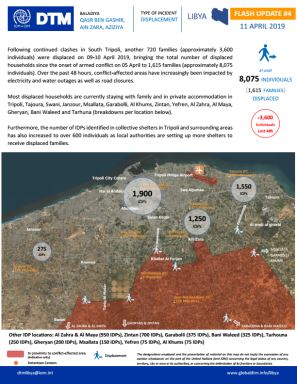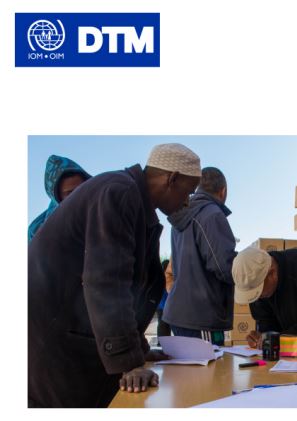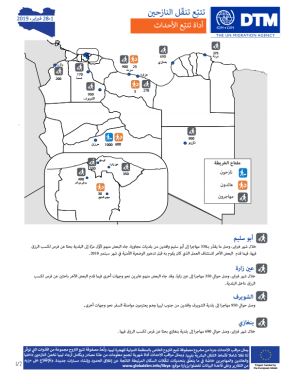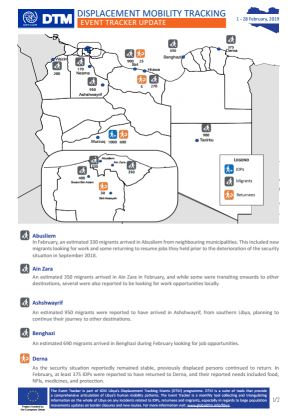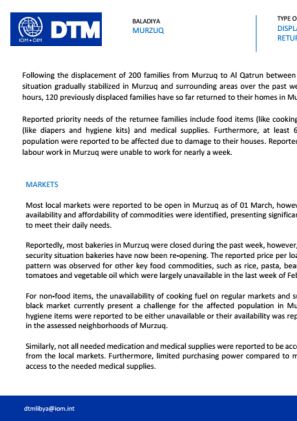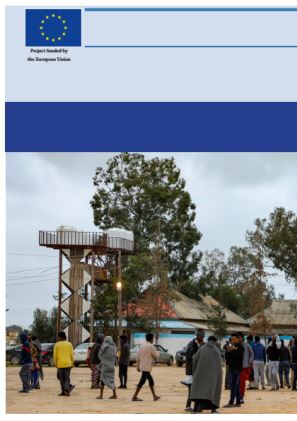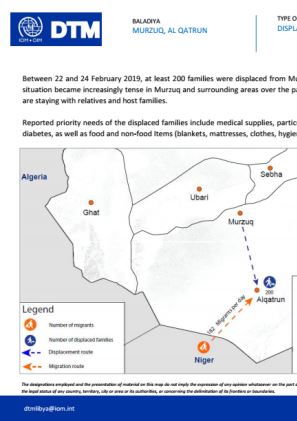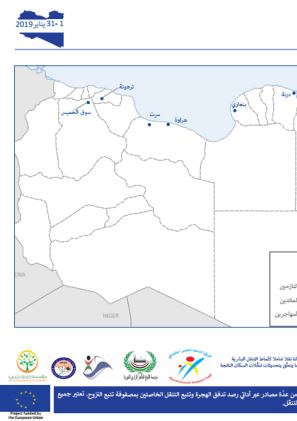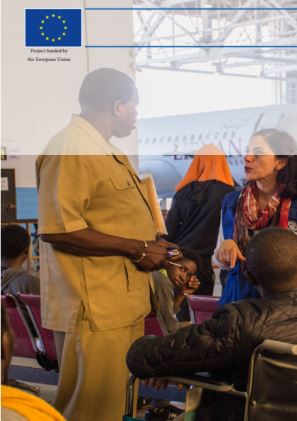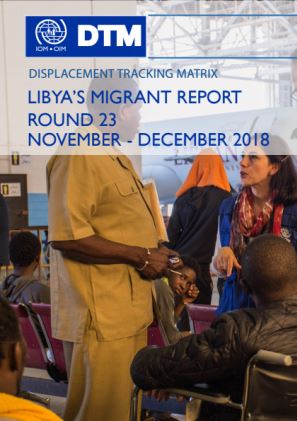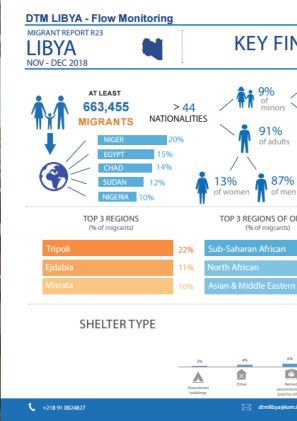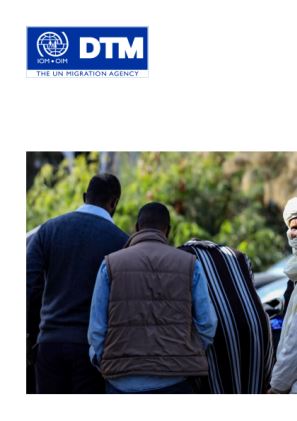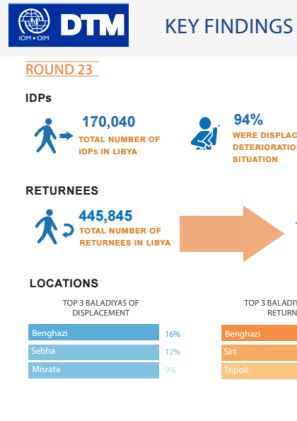-
Countries
-
Data and Analysis
-
Special Focus
-
Crisis Responses
Libya
About Libya
Libya is a geographically vast country with several regions that are difficult to access. In order to understand the full scope of humanitarian assistance that is needed throughout the country, IOM established the Displacement Tracking Matrix (DTM) programme in 2016 in order to provide a common operating picture concerning the movement of populations in Libya, allowing humanitarian actors to provide timely assistance to those in need. Following the escalation of conflict and insecurity in 2014, the security situation has remained volatile since with fluctuations in the intensity of localized clashes. Congruently, conflict has caused new displacements, often in areas ill-equipped to accommodate large population movements while also negatively impacting the large migrant population residing and transiting through Libya. More recently, the capital Tripoli was heavily affected by displacement waves in September 2018 and April 2019.
DTM’s mobility tracking and flow monitoring activities identified many migrants in-country to be in need of various forms of assistance. Libya’s geographic location, resources and work opportunities has made it both a country of destination and transit for migrants for many years. Despite the deterioration of the security situation since 2011 migrants continue coming to and transiting through Libya, the majority from Sub-Saharan and North African countries.
In this complex operating environment, DTM Libya has been providing a common operating picture concerning the movement of populations in Libya since 2016, allowing humanitarian actors to provide timely assistance to those in need. Through its mobility tracking, flow monitoring and needs assessment activities, DTM Libya has established itself as data hub for quantitative data on migratory flows to and within Libya, migrant presence in Libya disaggregated by nationality and area, as well as humanitarian needs of migrants, internally displaced population and returnees. All activities are implemented through periodical bi-monthly data collection cycles, allowing trend analysis over time to provide evidence-base for both policy-level discussions and to guide humanitarian action.
In order to facilitate humanitarian interventions, DTM works closely with IOM’s other programmes through referring identified populations in need of assistance at flow monitoring points to IOM’s Direct Assistance, Health, Voluntary Humanitarian Return (VHR), Protection and Migrant Rapid Response Mechanism (MRRM) programmes. Furthermore, DTM Libya supports other humanitarian partners through providing emergency tracking updates in case of sudden population movements as well as facilitating humanitarian assessments for the Rapid Response Mechanism (RRM) jointly implemented by IOM, UNICEF, WFP and UNFPA.
For more information on IOM's activities in Libya, please visit the IOM Libya country office website.
Contact
DTM Libya
DTMLibya@iom.int
Current Donors
- EUTF
Tripoli Flash Update 4 (11 April 2019)
Following continued clashes in South Tripoli, another 720 families (approximately 3,600 individuals) were displaced on 09-10 April 2019, bringing the total number of displaced households since the onset of armed conflict on 05 April to 1,615 families (approximate
Apr 11 2019
Tripoli Flash Update 4 (11 April 2019)
(January—February 2019) ليبيا — تقرير تتبّع أحداث النّزوح
ّيستعرض هذا التقرير نتائج الجولة الرابعة والعشرين 2019سنة
تحديث سريع عدد 3
نزحت 335 أسرة إضافية (حوالي 1.675 فرد) خلال الأربع والعشرين ساعة الماضية من جرّاء استمرار تصاعد أعمال العنف في جنوب طرابلس. ومنذ نشوب النزاع المسلّح في يوم 05 أبريل 2019، نزح عدد لا يقلّ عن 895 أسرة (حوالي 4.475 فرد) إلى مناطق أخرى من طرابلس ومسلاّته والقره بولي وغريان وبني وليد وترهونة.
Apr 09 2019
تحديث سريع عدد 3
Tripoli Flash Update 3 (09 April 2019)
Due to continued escalation of violence in South Tripoli, an additional 335 families (approximately 1,675 individuals) were displaced during the last 24 hours.
Apr 09 2019
Tripoli Flash Update 3 (09 April 2019)
Libya — Tripoli Flash Update 2 (07 April 2019)
After the onset of armed conflict in Suq Al Khamis, Aziziya and southern Tripoli on 05 April 2019, at least 560 families (approximately 2,800 individuals) have been displaced to other areas in Tripoli, Msallata, Garabolli, Bani Waleed and Tarhuna, including 250 families over the past 24 hours.
Apr 07 2019
Libya — Tripoli Flash Update 2 (07 April 2019)
Libya — Tripoli Flash Update (06 April 2019)
Following the escalation of armed conflict in Suq Al Khamis, Aziziya and southern Tripoli on 05 April, over the past 24 hours at least 310 households (approximately 1,550 individuals) have been displaced to other areas in Tripoli, Bani Waleed and Tarhuna.
Apr 06 2019
Libya — Tripoli Flash Update (06 April 2019)
Libya — IDP and Returnee Key Findings Report 24 (Jan-Feb 2019)
IDP and Returnee Round 24 Report Key Findings
Libya — IDP and Returnee Report 24 (Jan-Feb 2019)
This report presents the findings of round 24 of the mobility tracking component of the Displacement Tracking Matrix (DTM) in Libya, covering the reporting period January to February 2019. In Round 24, the number of identified returnees in Libya remained stable at 445,476 individuals.
Libya — Displacement Event Tracking Report (1- 28 Feb 2019)[ARABIC]
يغطّي تقرير أداة تتبّع الأحداث الخاصّ بليبيا جميع الأحداث المرتبطة بتنقّل السكان على امتداد شهر من الزمن. وخلال شهر فبراير من سنة 2019 ، سجّلنا أحداث متعلّقة بالنّزوح وتنقل السكان في 13 بلدية في مختلف أنحاء البلد.
Libya — Displacement Event Tracking Report (1- 28 Feb 2019)
DTM Displacement event tracking in Libya covers all the events related to population movements during one month. In February 2019, events related to displacements and population movements were recorded in 13 Muncipalities (Baladiyas) all over the country.
Libya — Detention Centre Profile Generator (February-2019)
Detention Centre Profiling is a component of IOM Libya’s Displacement Matrix programme. It is a data oriented tool that routinely provides specific sex and age demographic data and key sectorial information on individuals held in Libya’s detention Centres.
Libya — Murzuq Alert Snapshot-2 (3 March 2019)
Following the displacement of 200 families from Murzuq to Al Qatrun between 22 and 24 February, the security situation gradually stabilized in Murzuq and surrounding areas over the past week.
Mar 03 2019
Libya — Murzuq Alert Snapshot-2 (3 March 2019)
Libya — Migrant Report 25 (March—May 2019) [Arabic]
أجريت الجولة الخامسة والعشرين لتجميع البيانات الخاصّة بالهجرة خلال أشهر مارس وأبريل ومايو من سنة 2019 . وتمكّنت مصفوفة تتبّع النزوح من إحصاء ما لا يقلّ عن 641.398 مهاجرا يعود أصلهم إلى أكثر من 39 دولة مختلفة وهم موجودون حاليا في جميع بلديات ليبيا وفي داخل 565 محلّة.
Libya — Murzuq Alert Snapshot-1 (26 Feb 2019)
Between 22 and 24 February 2019, at least 200 families were displaced from Murzuq to Al Qatrun as the security situation became increasingly tense in Murzuq and surrounding areas over the past week. Reportedly, IDP families are staying with relatives and host families.
Feb 26 2019
Libya — Murzuq Alert Snapshot-1 (26 Feb 2019)
Libya — Baladiya Data Generator Round 23 (November - December 2018)
This is an interactive profile generator that displays snapshots of each of Libya’s 100 baladiyas gathered through DTM Libya’s Mobility Tracking assessments. Basic multisectorial data on the baladiya is presented in addition to data on IDPs, returnees and and migrants in the baladiya.
Libya — Detention Centre Profile Generator (January 2019)
Detention Centre Profiling is a component of IOM Libya’s Displacement Matrix programme. It is a data oriented tool that routinely provides specific sex and age demographic data and key sectorial information on individuals held in Libya’s detention Centres.
Libya — Displacement Event Tracking Report (1- 31 Jan 2019)
Approximately 990 migrants reportedly arrived in Benghazi in January 2019 looking for work opportunities. The security situation in most neighbourhoods of Derna remained stable during the reporting period, except the old city.
Libya — Displacement Event Tracking Report (1- 31 Jan 2019) [Arabic]
خلال شهر يناير من سنة 2019، بلغنا وصول قرابة 990 مهاجرا إلى بنغازي في إطار بحثهم عن سُبُل لكسب الرّزق. ظلّ الوضع الأمني في أغلب أحياء درنة مستقّر خلال الفترة المشمولة بالتقرير باستثناء المدينة القديمة.
Libya — Migrant Report 23 (Nov - Dec 2018) - Arabic
أجريت الجولة الثالثة والعشرين لتجميع البيانات الخاصّة بالهجرة خلال شهري نوفمبر وديسمبر من سنة .2018 وتمكّنت مصفوفة تتبّع النزوح من إحصاء ما لا يقلّ عن 663.445 مهاجرا موجودين حاليا في جميع بلديات ليبيا وفي داخل 571 محلّة. ويعود أصل المهاجرين إلى أكثر من 44 دولة.
Libya — Migrant Report 23 (Nov - Dec 2018)
In Round 23, DTM identified there to be at least 663,455 migrants in Libya. Migrants were identified in all baladiyas, within 571 communities and originated from more than 44 countries.
Feb 06 2019
Libya — Migrant Report 23 (Nov - Dec 2018)
Migrant Report Key Findings 23 (Nov - Dec 2018)
DTM Libya Round 23 Key Findings
Feb 06 2019
Migrant Report Key Findings 23 (Nov - Dec 2018)
Libya — IDP and Returnee Report 23 (Nov-Dec 2018) [Arabic]
يستعرض هذا التقرير نتائج الجولة الثالثة والعشرين المستخلصة من عمل وحدة تتبّع التنقل الخاصّة بمصفوفة تتبع النزوح في ليبيا والتي تغطّي الفترة الممتدة بين شهري نوفمبر وديسمبر . من سنة 2018 وفي الجولة الثالثة والعشرين، ارتفع عدد العائدين في ليبيا من 403,978 فردا ليبلغ 445,845 عائدا.
Libya — IDP and Returnee Key Findings Report 23 (November - December 2018)
This report presents the findings of round 23 of the mobility tracking component of the Displacement Tracking Matrix (DTM) in Libya, covering the reporting period November
Libya — IDP and Returnee Report 23 (November - December 2018)
This report presents the findings of round 23 of the mobility tracking component of the Displacement Tracking Matrix (DTM) in Libya, covering the reporting period November
Pagination
Pagination
- First page
- Previous page
- 1
- 2
- 3
- 4
- 5


